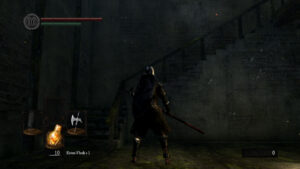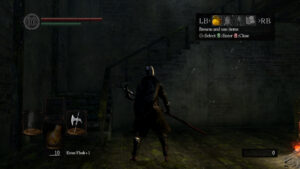Dark Souls: Halftime Status Report
Immediately after the tutorial area, you’re told that your mission is to ring this bell. I forget why, but it’s important. It’s magic or something. But shortly after you’re told this, the keeper of the Firelink Shrine chuckles and informs you that actually there are TWO bells, one far above and one far below, and you have to ring them both. It’s a pretty minimal revelation, a modification of information you received less than a minute prior, but it’s an easy way for the writers to convey the intended vibe: that things are going to be harder than expected.
I bring it up now because I’ve now rung one of the bells. It’s likely that I could have done this a while ago; the gargoyles guarding it were entirely too tough for me when I first found them, which is basically your signal to go exploring for a while until you have better stats and better gear, and I spent long enough at this that the gargoyles were fairly easy when I worked up the courage to give them another try. As a result, I’ve seen ten of the game’s twenty-odd zones, albeit only briefly in some cases. I keep finding passages to new zones in areas that I thought I had explored thoroughly but hadn’t — the level design is good at exploiting 3D to hide stuff.
I’ve basically been playing as a pure melee character, but only half by choice. This is one of those RPGs where there isn’t really a hard distinction between character classes, where your choice of class determines your starting stats and starting equipment but both of these things change as you progress. I chose the Wanderer class, who starts off with a scimitar that can chain attacks and a cool coat with a bunch of resistances, and I had a vague plan of being a Dexterity-based fighter, dodging and weaving and killing with a flurry of fast blows. But I’ve wound up sinking a lot more points into Strength than Dexterity, and it’s mainly because I’ve found several weapons with very high Strength requirements and none with very high Dexterity requirements. Also, I’ve come to really appreciate the way the high-Strength weapons end fights quickly, often with a single blow. My preferred weapon for most things other than bosses is a halberd that I’ve upgraded to +5: it has the power of a greataxe and the reach of a spear, and its only real drawback is that you can’t just wave it around in the hope of hitting something like you can with the scimitar; you pretty much have to target-lock enemies to have any chance of hitting them with it.
So that’s me now: the heavy-hitter with a halberd. I’d hoped to have some spellcasting ability by now, if only to try it out and see how spells work in this game, but it hasn’t really worked out. The only spell merchant I’ve met is a cleric, whose offerings didn’t impress me enough for me to put enough points into Faith to be able to use them. There are supposed to be Sorcerer and Pyromancer spells, so where are they? It’s entirely possible that they’re sitting around perfectly accessible in some nook of the map that I’ve passed by a thousand times. That’s the downside to discovering new stuff every time you explore: it means there’s always been stuff you could have found already but haven’t.
 Comments(1)
Comments(1)
